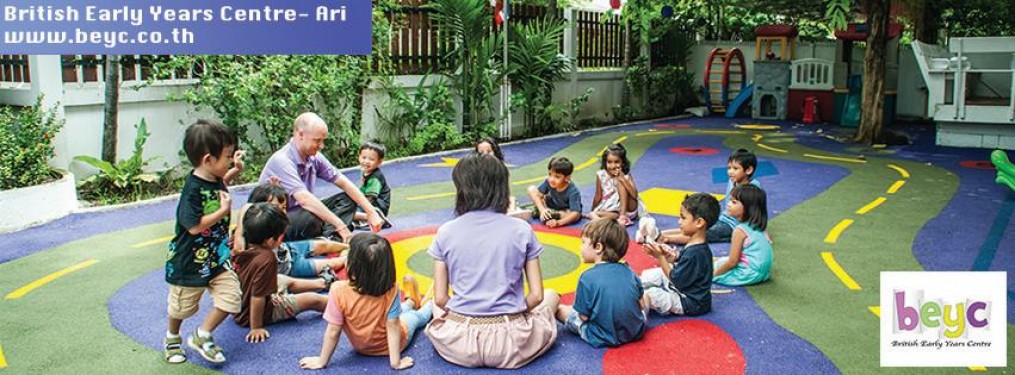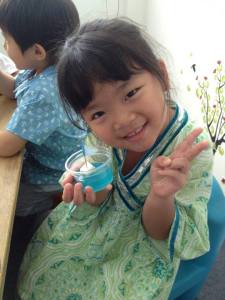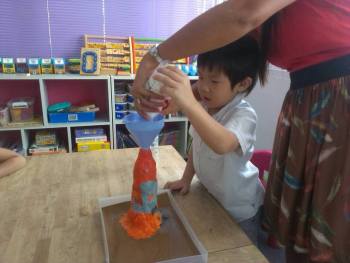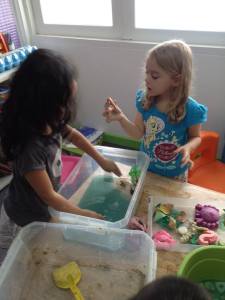fun learning
Fun snacks for healthy kids
Trying to get children to eat healthily can be difficult. Here are three creative ideas that can be as fun to make as they are to eat.
Watermelon Pizza
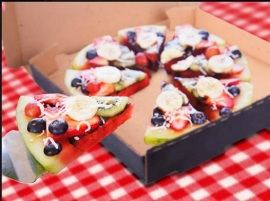
A very simple idea that can be used in role play as well. Set up a pizza shop and call up your child to place an order. Ask for recommendations and allow your child to decide what to put on the pizza. Let your child deliver the pizza and take payment. Try swapping roles and let your child make an order and then make it together. Make sure you have lots of ingredients to choose from. You can use a light cream to keep the pieces in place.
Real Fruit Lollies
To make t hese delicious fruit lollies you will need:
hese delicious fruit lollies you will need:
16 ounces of pressed apple juice
1 ounce of cold water
1 teaspoon of lemon juice
Slices of fresh fruit.
Directions: simply stir all the ingredients together, adding the fruit last and freeze.
N.B. This will make quite a lot. The apple juice has a lot of sugar so feel free to play with the ratios and replace juice with plain water.
Click here for more lollipop recipes.
Homemade Ice Cream
For this recipe you don’t need an ice cream maker and not only is it great fun to make, it also teaches children a bit of science too.
Things you will need:
1/2 cup milk
1/2 teaspoon vanilla
1 tablespoon sugar
4 cups crushed ice
4 tablespoons salt
2 quart size Zip-loc bags
1 gallon size Zip-loc freezer bag
a hand towel or gloves to keep fingers from freezing
Directions:
Mix the milk, vanilla, and sugar into one of the small Zip-loc bags and close. If you double bag there is less risk of splitting and the ingredients mixing with the salt and ice. Then place the smaller bag into the larger bag, which you fill with the ice and the salt. Close the bigger bag and then shake and massage the bags. Try to make sure that ice touches all parts of the inner bag. This does take 10-15 minutes depending on how rigorous you are but is good fun. When the ice cream solidifies, open it up and eat straight from the bag.
Benefits of Reading 2- Ideas and Activities
Reading in the womb
It is never too early to begin reading to your child. Even reading whilst the child is in the womb has been proven to have significant benefits to their abilities. The University of Florida found that a Foetus between the 28th and 34th weeks of pregnancy could remember familiar nursery rhymes. These findings suggest that babies are much more susceptible to being influenced by their surroundings before birth than previously thought.
There are many different ways you can stimulate your baby whilst they are in the womb:
- Sharing music and play some classical songs while allowing your child to listen.
- Read simple stories or tell your child what has been happening that day.
- Sing simple songs and nursery rhymes.
- Talk to your child and allow them to hear different familiar voices; siblings; Aunt Kate; Uncle Robert; Dad and Mum.
Reading with babies
According to The American Academy of Pediatrics reading is an essential part of quality development. It stimulates imagination, creativity and improves communication skills. It also introduces children to numbers, letters, colours, shapes and other topics. This is the age when a two way interaction between parent and child can begin to form.
- Children love routine, so making a set time to read with your child is vital. This will set the foundation for your child to enjoy reading right the way through childhood.
- Your child won’t understand everything that you are saying but by reading together and looking at the books, your child will start to recognize every day words.
- Choose brightly coloured books with simple pictures. You don’t want to overload your child with too much information; allow them to use their own creativity. As you read with your child, point to pictures, change the sound of your voice to suit different characters and allow your child time on each page. Interactive books that you can touch and feel are great for children to develop their senses.
- Reciting nursery rhymes and dancing is also a great way to stimulate creativity and imagination. Don’t fall into the trap of just reading them out to your child, rather, be energetic, smile and bring the songs and stories to life. Your child will react to your body language so remember to enjoy this moment yourself.
- Using your child’s toys to make up stories also breeds familiarity and allows the children to continue their creativity when you stop reading.
Reading with young children
Between the ages of 2 and 3 children see a huge development in language and vocabulary skills. In fact according to Barbara Zurer Pearson, author of “Raising a bilingual child”, children are even capable of distinguishing between languages, so the more languages they are surrounded by the better. This is also a great age for sharing reading as children become more responsive. There are many phonics games that you can play at this age and these can be found on our videos page on facebook as well as on our phonics page within the blog. In terms of just reading there are many ways to share:
- Choose books with repetition- Children love knowing what’s coming next and love repeating phrases they are familiar with. It brings them into the story and enables them to join in without being able to read themselves.
- Act out the story with your child- Once you finish reading a story and the child is familiar with it, act it out. You could build a castle out of bed sheets, or houses made of sticks and really get your child living the story.
- Ask children to draw their favourite character from the story- Discuss what clues from the story help describe the character. You could even ask the children to make up a new character for the story.
- Hot seat- Let children read their favourite book and then put them in the hot seat. They can choose their favourtie character before being interviewed on their role in the story. Swap roles and let them ask you as well.
- Make up a story together- With your child verbally make up a story together. You could take this one further and write captions and let your child illustrate; creating your own story book together.
- Make a photo story- Take a trip with your child and take photos together. Allow your child to create sentences about what you are doing in each photo. With more advanced learners you could write a joint diary writing down how you felt at different parts of the day. This also allows the children to empathise with your feelings and perspectives as well.
- Look for books together- One of the most overlooked and important parts of reading, is going to find books together; ones that you can both share.
- Hidden messages- This is a fun way to get your child to enjoy reading. Write them special notes and leave them round the house. Reward them for finding them, “ask Mum for a cookie”.
- Treasure hunts- Children love going on treasure hunts. Dress up as pirates for the day and set up an obstacle course. Take children round the house following clues to find the treasure.
- Role play- Sit and have tea with your child’s dolls, or act out a World Cup final. Find out what your child enjoys and make up a story with them. You can either improvise or make up the story first and then act it out.
- Share the reading load- If your child is beginning to read independently, it can seem daunting to have to read a whole book or even a whole page so break it up. Read one line each and act like you are struggling. Ask for help rather than demand your child reads. Let your child know that even adults struggle at times and it is nothing to be ashamed of.
The most important part of shared reading is to look for the things that your child enjoys the most. Not all of these ideas will work for every child. There are many ways to peak a child’s interest. Try to pick ideas that share the reading experience and you will both be much happier for it.
For more information on the benefits of reading, please take a look at our earlier post The Benefits of Reading With Children
Discovery boxes
One of my fondest memories of being young was my “busy box”. In my busy box were a variety of objects, from recycled egg boxes and felt strips to plastic bottles and cereal boxes. It was my treasure chest of creativity. Anything that could be reused was put into my box by my Mum. It was such a simple thing, but I loved it. I wasn’t the most imaginative child but when I opened my busy box my mind became a factory of ideas. My busy box was always around handy for a rainy day and what was even better was that a close friend had one of his own, so whenever we went to one another’s houses, we would often share pieces of junk. Not only did it fuel my creativity but it helped me develop relationships with friends through play.
Here are some great ideas to help you start your own busy box, courtesy of Imagination Tree…
Fun art game to play at home
I asked one of the students today what their favourite game to play in class was. I didn’t expect the answer to be “spelling with Teacher Nick”! Anyway here is a fun arty game to play courtesy of http://www.gluedtomycraftsblog.com
Gardening with the kids
Take a look at this thorough article on gardening with kids. It includes reasons why gardening is so important for young children, offers advice on how to grow at home and explains which plants are the easiest to cultivate. Start off with quick and easy plants to grab the children’s interest and as they get more involved move on to longer term projects. Living in Bangkok, it is especially important to let children see the beauty of nature from a hands on perspective. If you live in a condo, growing a few simple things on a balcony is still a great distraction from an ever growing technological world. Read more…
How to help develop pre-writing skills
Here is a great way to help children to develop pre-writing skills. Pre-writing skill development sets the foundation for children to develop quickly when they pick up a pencil. Fine motor skills are the ability to make small precise movements with control, using fingers, wrists and hands. The strengthening of these muscles from an early age is very important and there are lots of fun ways to do it.
Fine motor skills are not only important for writing— they are necessary in order to button and zip clothes, tie shoes, and later learn to read without difficulty. Eye-hand coordination is a prerequisite for developing the visual perception necessary to read from left to right (Beaty, 1979).
Additional content sourced from Early Childhood News
Applying play to discipling children
Discipling your child in the correct way is vital. Children need to learn the difference between right and wrong, however this can sometimes be difficult and lead to children being scared to express themselves and challenge authority. It is important to always allow time to explain to your child why you are disappointed with their behaviour and give them a chance to think about the consequences of their actions. A lot of the time children don’t know why they are being punished even though it is obvious to us adults.
Here are some great ideas that encourage discipline through creative play. Not only can your child learn rules but also they can begin to empathise through role play and find the correct ways to channel their frustrations. The activities also give parents a chance to see their children in a different light and may help in finding the route of bad behaviour.
http://truparenting.net/5-specific-examples-apply-play-discipline/
“O” for orange- water play activity
For younger children it is not only important to help them to grasp a concept of phonics and maths but also to encourage them to explore themselves and the world around them. Here is a great idea involving manipulative water based play. It is a holistic learning activity; great fun for any young child. Click here for more details.

